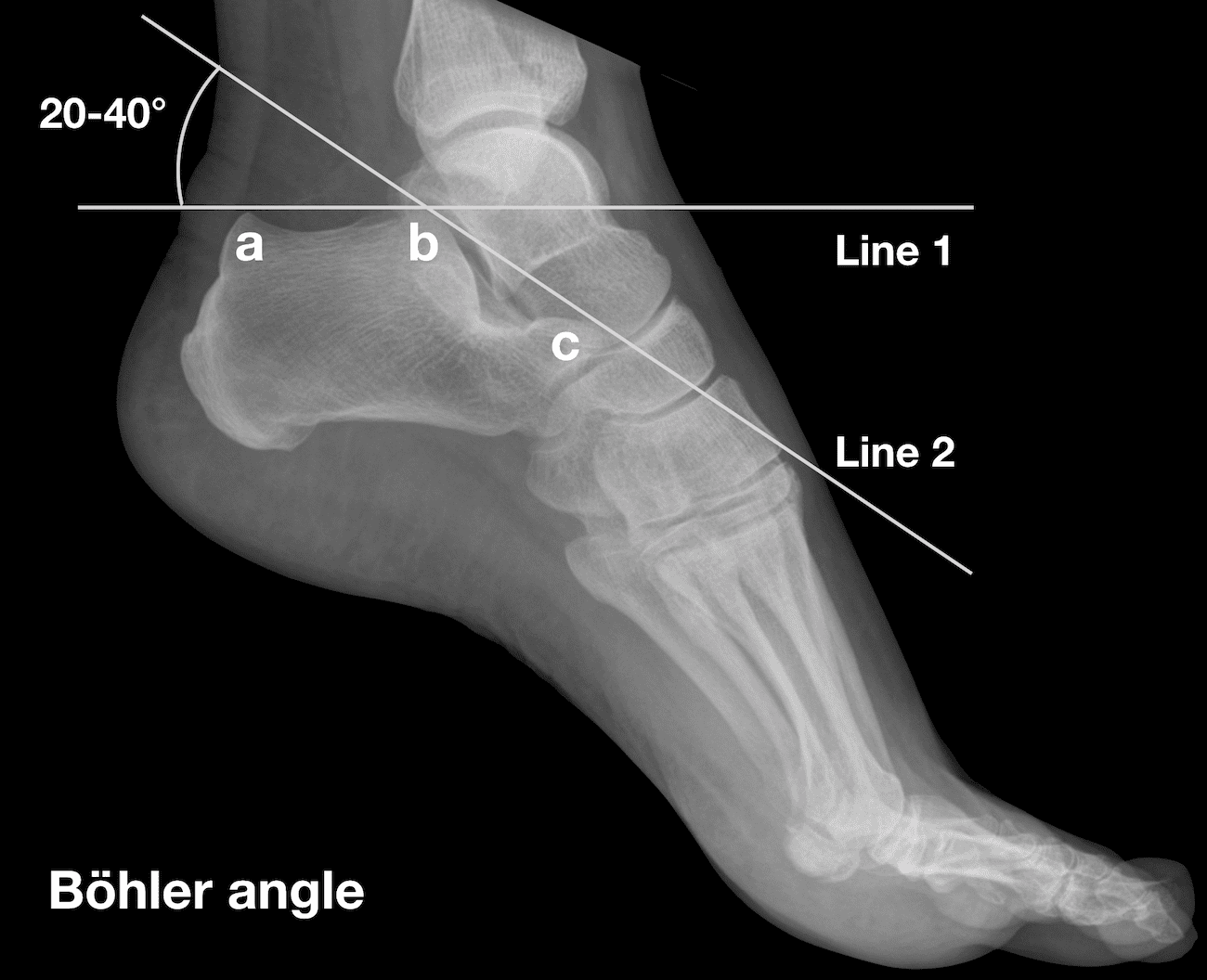Böhler angle
Description
Böhler angle: The angle between line from highest point of anterior process to highest point of posterior facet plus line tangential to superior edge of tuberosity; measured on lateral foot x-ray. Normally 20-40°. If < 20° represents a calcaneal fracture (or more specifically a collapse of the posterior facet)
[aka Boehler angle, Bohler angle, tuber-joint angle, calcaneal angle]
- Line 1: Drawn between the most cephalic part of the posterior process of the calcaneus bone (point a) and the most cephalic point of the posterior facet of the calcaneus bone (point b)
- Line 2: Drawn between the most cephalic point of the posterior facet of the calcaneus bone (point b) and the highest point of the calcaneus bone articulating with the cuboid bone (point c)
History of the Böhler angle
1931 Lorenz Böhler (1885 – 1973) first proposed the use of the tuber-joint angle to assist in determining fractures of the calcaneum.
Normally there exists, between the upper contour of the tuberosity of the os calcis and the line uniting the highest point of the anterior process with the highest point of the posterior articular surface, an angle of thirty to thirty-five degrees. This angle I have named the “tuber-joint angle“. In fractures of the os calcis this angle becomes smaller, straight, or even reversed
Böhler 1931
- Fig 5. Normal tuber-joint angle of 40 degrees in a normal os calcis. The longitudinal axis of the astragalus (talus) is inclined.
- Fig 6. Tuber-joint angle of 20 degrees in a mild fracture of the os calcis. The longitudinal axis of the astragalus (talus) approaches the horizontal
1991 Chen et al reviewed 120 consecutive ankle radiographs for ankle injuries but normal bone anatomy the mean +/- SD of Bohler’s angle was 30 +/- 6 degrees (range, 14 to 50 degrees), no differences between gender, no differences between right or left ankles. They found that the use of 20 degrees as the lower limit may decrease the number of false-positive to three cases (2.5%); using 18 degrees (mean -2 SD) reduces the false-positive rate to less than 1% (one case).
2002 According to Buckley et al, patients with Bohler’s angle <10 degrees, comminuted fracture patterns, large initial joint step-off, women, non-workman’s compensation cases, and younger patients (age <29) have improved outcomes with surgery.
2006 Knight et al found published a randomized, blinded, case-control study of 133 patients found that emergency physicians were 97.9% accurate at diagnosing calcaneus fractures without the assistance of angles, but that determining Bohler’s angle can still be helpful and has good interrater reliability.
Controversies
Discrepancy between the normal angles of 20-40°; 28-40°; and 25-45°
Associated Persons
- Lorenz Böhler (1885-1973) [Böhler angle]
- William Gissane (1898-1981) [Critical angle of Gissane]
Alternative names
- Boehler’s angle, Bohler’s angle
- Tuber-joint angle, tuber angle
- Calcaneal angle
References
Historical articles
- Böhler L. Diagnosis, pathology and treatment of fractures of the os calcis. J Bone Joint Surg 1931; 13: 75-89
Review articles
- Chen MY, Bohrer SP, Kelley TF. Boehler’s angle: a reappraisal. Ann Emerg Med. 1991; 20(2): 122-4.
- Sanders R. Intra-articular fractures of the calcaneus: present state of the art. J Orthop Trauma. 1992; (2): 252-265.
- Buckley R et al. Operative compared with nonoperative treatment of displaced intra-articular calcaneal fractures: a prospective, randomized controlled multicenter trial. J Bone Joint Surg Am. 2002; 84: 1733-1744.
- Knight JR, Gross EA, Bradley GH, Bay C, LoVecchio F. Boehler’s angle and the critical angle of Gissane are of limited use in diagnosing calcaneus fractures in the ED. The American Journal of Emergency Medicine, 2006; 24(4): 423–427
- Boyle MJ et al. The paediatric Bohler’s angle and crucial angle of Gissane: a case series. Journal of Orthopaedic Surgery and Research 2011, 6:2
- Arslan G, Yirgin IK, Tasguzen A. A measuremental approach to calcaneal fractures. Eur J Trauma Emerg Surg. 2014; 40(5): 593-9
- Busti AJ. Bohler’s Angle: How to Determine Presence of a Calcaneus Fracture. EBM Consult. 2015
- Gomez A, Cadogan M. Eponymythology of foot injuries. LITFL
- Cadogan M. Böhler angle. Eponym A Day. Instagram
[cite]
eponymictionary
the names behind the name
Resident medical officer in emergency medicine MB ChB (Uni. Dundee) MRCS Ed. Avid traveller, yoga teacher, polylinguist with a passion for discovering cultures.



